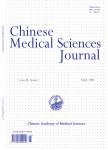Perihematomal Perfusion Typing and Spot Sign of Acute Intracerebral Hemorrhage with Multimode Computed Tomography: A Preliminary Study
Perihematomal Perfusion Typing and Spot Sign of Acute Intracerebral Hemorrhage with Multimode Computed Tomography: A Preliminary Study作者机构:Department of Neuroradiology Beijing Tiantan Hospital Capital Medical University
出 版 物:《Chinese Medical Sciences Journal》 (中国医学科学杂志(英文版))
年 卷 期:2014年第29卷第3期
页 面:139-143页
核心收录:
学科分类:1002[医学-临床医学] 100204[医学-神经病学] 10[医学]
主 题:intracerebral hemorrhage computed tomography perfusion computed tomography angiography
摘 要:Objective To explore the perihematomal perfusion typing and spot sign on computed tomography angiography(CTA) source images in order to assist in individualizing therapeutic decisions for patients with intracerebral hemorrhage by possibly forecasting perihematomal ischemia and hematoma enlargement. Methods We examined 58 patients with spontaneous intracerebral hemorrhage by computed tomography perfusion and CTA within 6 hours after symptom onset. Hematoma volumes were determined from non-contrast CT images and compared between first and second CT images. The perfusion of hematoma region and perihematoma region was evaluated for presence or absence of the perihematomal penumbra. Three kinds of perihematoma perfusion typing were defined according to the perfusion of hematoma region and perihematoma region. CTA source images was reviewed to make sure presence or absence of the spot sign. Results Finally, 53 patients(34 males, 19 females) were enrolled in our study according to exclusion criteria. Finally, 21 patients were classified into the normal group, 23 patients were classified into the mild group, and 9 patients were classified into the severe group. There were significant differences in hematoma size between the presence and absence of the perihematomal penumbra group(P0.05). Thirteen(24.5%) patients presented with spot sign. Hematoma expansion occurred in 15(28.3%) patients on follow-up. In which 12 patients were with spot sign. Sensitivity, specificity, positive predictive value, and negative predictive value for expansion were 80.0%, 97.4%, 92.3%, and 92.5%, respectively. Conclusion In acute intracerebral hemorrhage patients, the perihematoma perfusion typing and CTA spot sign provide more radiological information that might assist in individualizing therapeutic decisions for patients by possibly forecasting perihematomal ischemia and hematoma enlargement.



